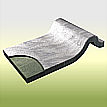
Two different methods are used: low cyanogen and acid electrolytes. The first gives a better material distribution, the second is faster and avoids hydrogen embrittlement.
Nickel plating (Ni) is used for decoration and corrosion protection of steel, copper, aluminium and magnesium, for smoothing out surfaces, for black coatings, and for renewing worn machines components. Mostly applied prior to chromium plating.
Two different electrolytes are used. The first, Watt's solution, is based on nickel sulphate, nickel chloride and boric acid. The second, nickel sulphamate, is based on a salt nickel sulphamate.
Danish Name
Category
Materials
Zinc (Zn)
Nickel (Ni)
Substrates:
Steel
For nickel also:
Copper (Cu)
Aluminium (Al)
Magnesium (Mg)
Typical products
Shopping basket (Zn)
Water tap (Ni)
ReferencesGalvanisk Kompagni A/S
Gelsed Galvano Industri A/S
Price notes
| DKK/part | 5 parts | 100 | 5000 |
| Small (1cm2) | 84/84/84 | 11/11/11 | 0.036/0.063/0.089 |
| Medium (1dm2) | 113/115/118 | 18/20/23 | 0.22/0.48/0.91 |
| Large (100dm2) | 161/224/302 | 43/107/185 | 9/34/78 |
Price date
Environmen- tal notes
Additional info
Photo
Copyright
This page is part of Design inSite
Disclaimer